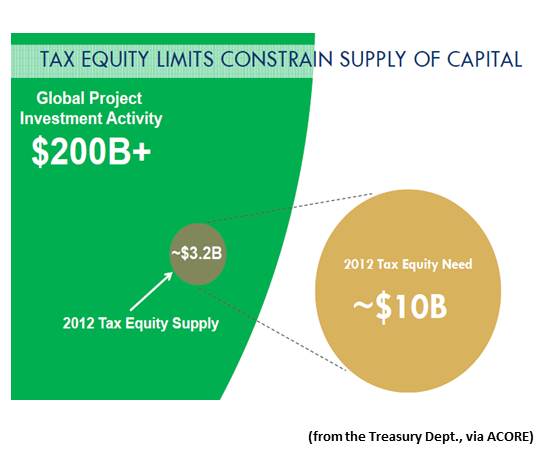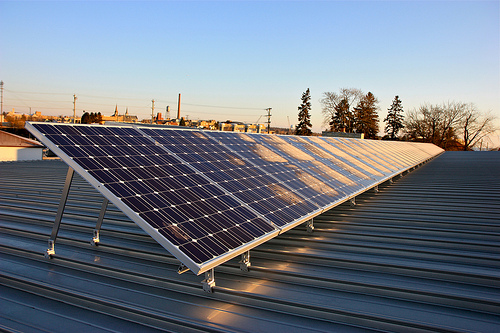In the next two years, the U.S. may get a lot less solar and wind power than it could.
It’s not a shortage of solar panels or the cost of turbines. Rather, it’s a problem of the perverse nature of federal incentives for renewable energy. Right now, the owner of a solar or wind energy project can get a federal tax credit based on the value of the project or the electricity it produces. But many owners don’t have enough tax liability to make use of the entire credit, and their search for a “tax equity” partner has created a logjam in the renewable energy market.
As reported in Greentechmedia,
CITI calculates there is a need in solar for $10 billion to $12 billion in tax equity for 2012 through 2014, but not more than $5 billion in tax equity is available. That, Salant said, is “a massive supply-demand imbalance” that is not “going away anytime soon.” [emphasis mine]
The following graphic (from the article) illustrates:
A big part of this big money problem is a focus on big projects (and technologies that can’t economically be done at small scale):
“PV can be done on a much smaller scale and be economic, and a large project can be done in phases. It’s a lot easier to finance $250 million or $500 million than it is to get $3 billion all at once.” [Concentrating solar power] requires vital economies of scale “so you’ve got to raise $2 billion all at once. That’s a lot harder to do than to raise $500 million four times.”
That’s a small-scale solution to a big problem. There may be a handful more folks who can invest $500 million than $2 billion.
But there are millions more Americans who could invest a few thousand dollars in community-based solar and wind power. In 2009, American taxpayers cumulatively paid $865 billion in federal income taxes. If just 1 in 100 could invest in a renewable energy project, it would nearly quadruple the tax equity market (from $3.2 billion to ~$12 billion). And since 1 in 3 Americans will be able to get electricity from rooftop solar for less than their utility provides in the next decade, policy makers should find a way to open the small investor floodgates
The answer is community-based solar and wind projects, for three reasons:
- Economies of scale (without excessive size)
- Smaller investment increments (financed with bank loans and paid back with energy savings)
- Much greater political support
But there are three policy solutions needed to enable community power:
- Community net metering – to allow project owners to share the project’s electricity output. Right now, most state policies require utilities to allow net metering, but only for a solar or wind project on your own property.
- Simplified securities law – to make community-based projects easier. Right now, there’s little difference between setting up a mutual fund and setting up a community solar project, and both take a lot of lawyers. (Learn more in this report)
- Smarter federal tax incentives – to allow community-based institutions to host community-based projects. Non-profits, cooperatives, cities and counties are logical entities to build projects, but they can’t (easily) use federal tax incentives for solar and wind power. This raises the stakes for problem #2.
Some of these policy solutions are already in play. As many as eight states already offer community net metering. The federal 1603 cash grant (now expired) was one of the best tools for community-based projects (like this one); President Obama has proposed another solution.
The U.S. could spend the next few years letting wind and solar power development lag because of artificial financing constraints. Or policy makers could use two or three carefully crafted tools to open the floodgates to a massively democratic investment in local, clean energy.





